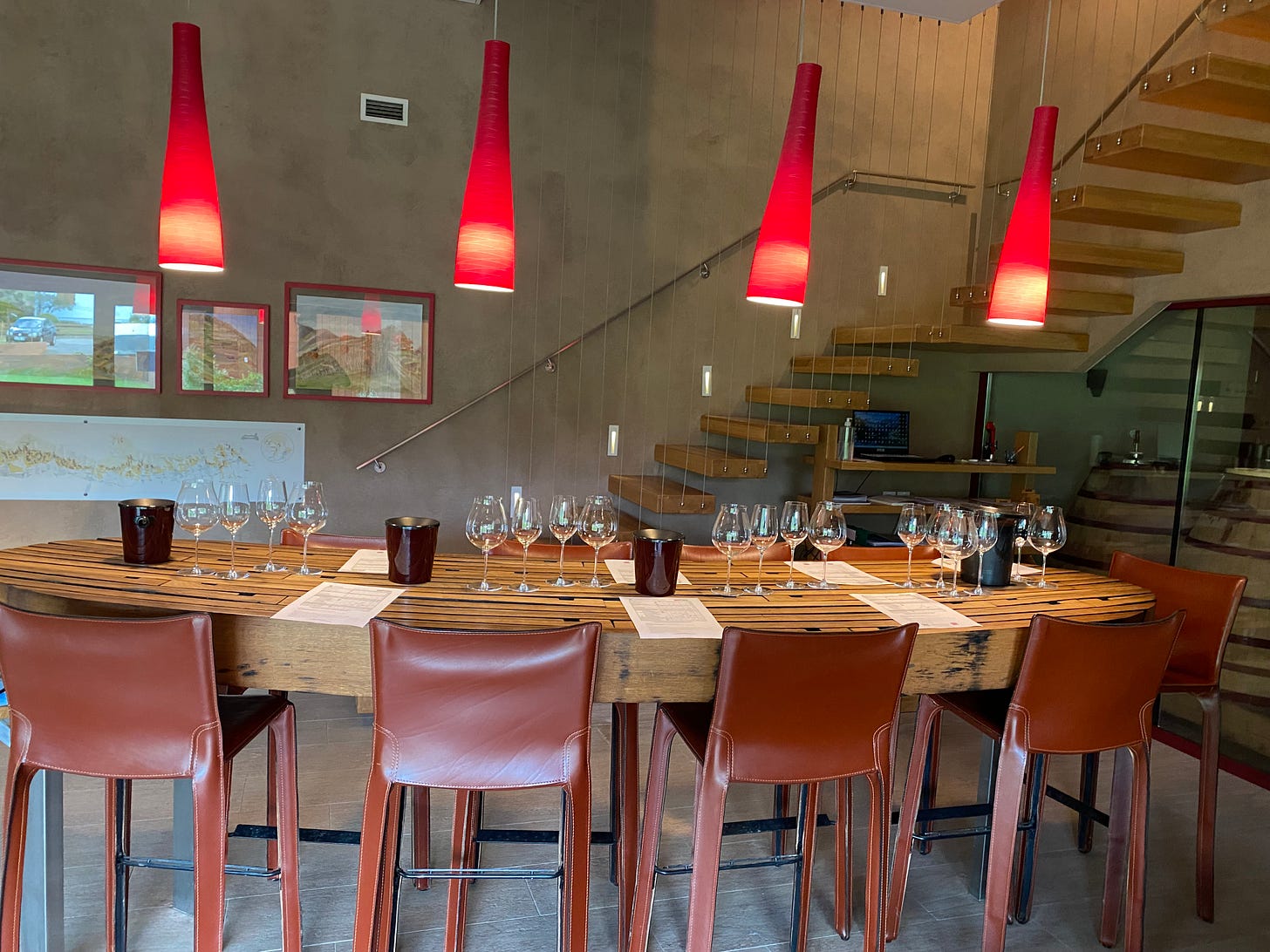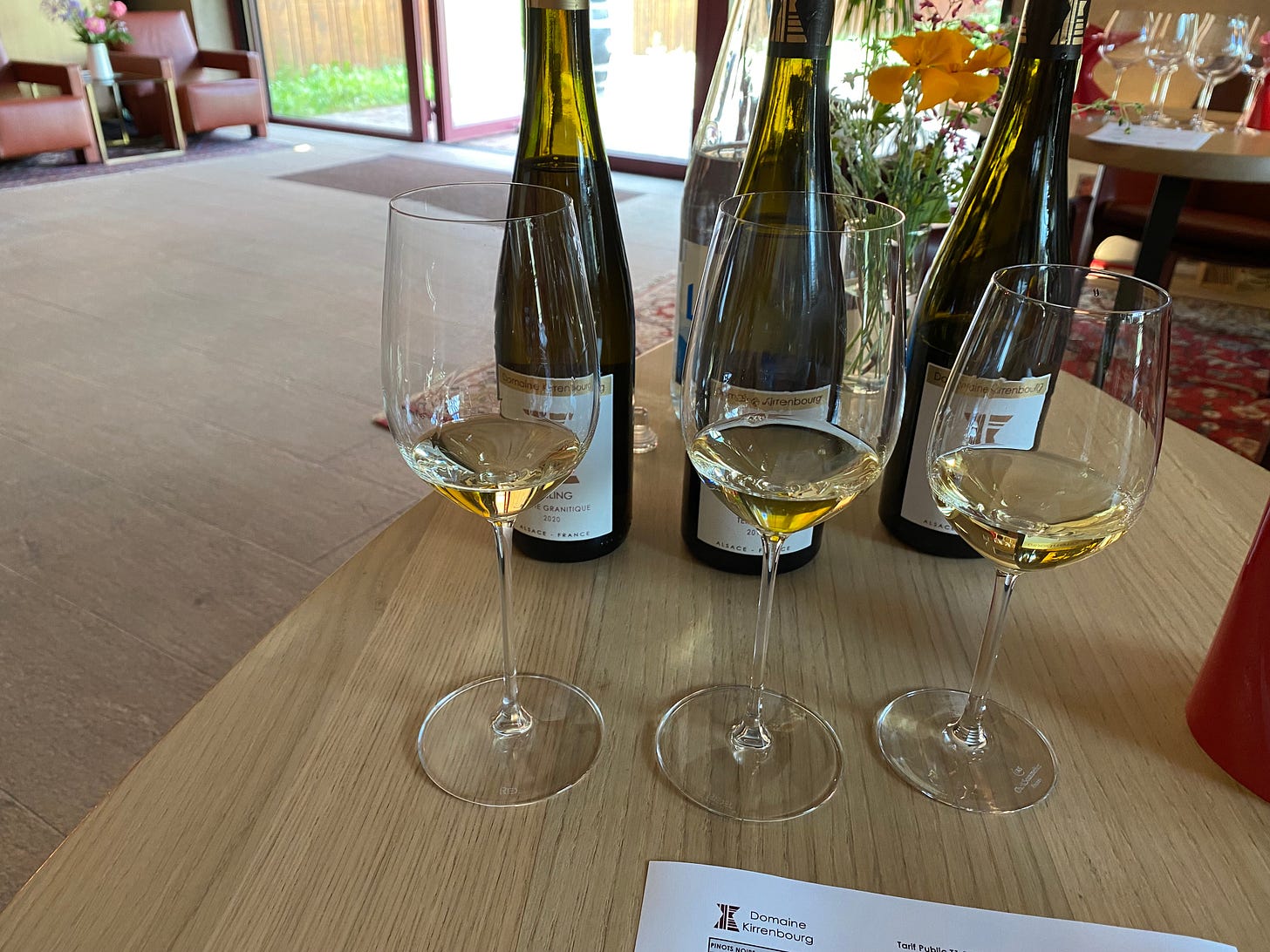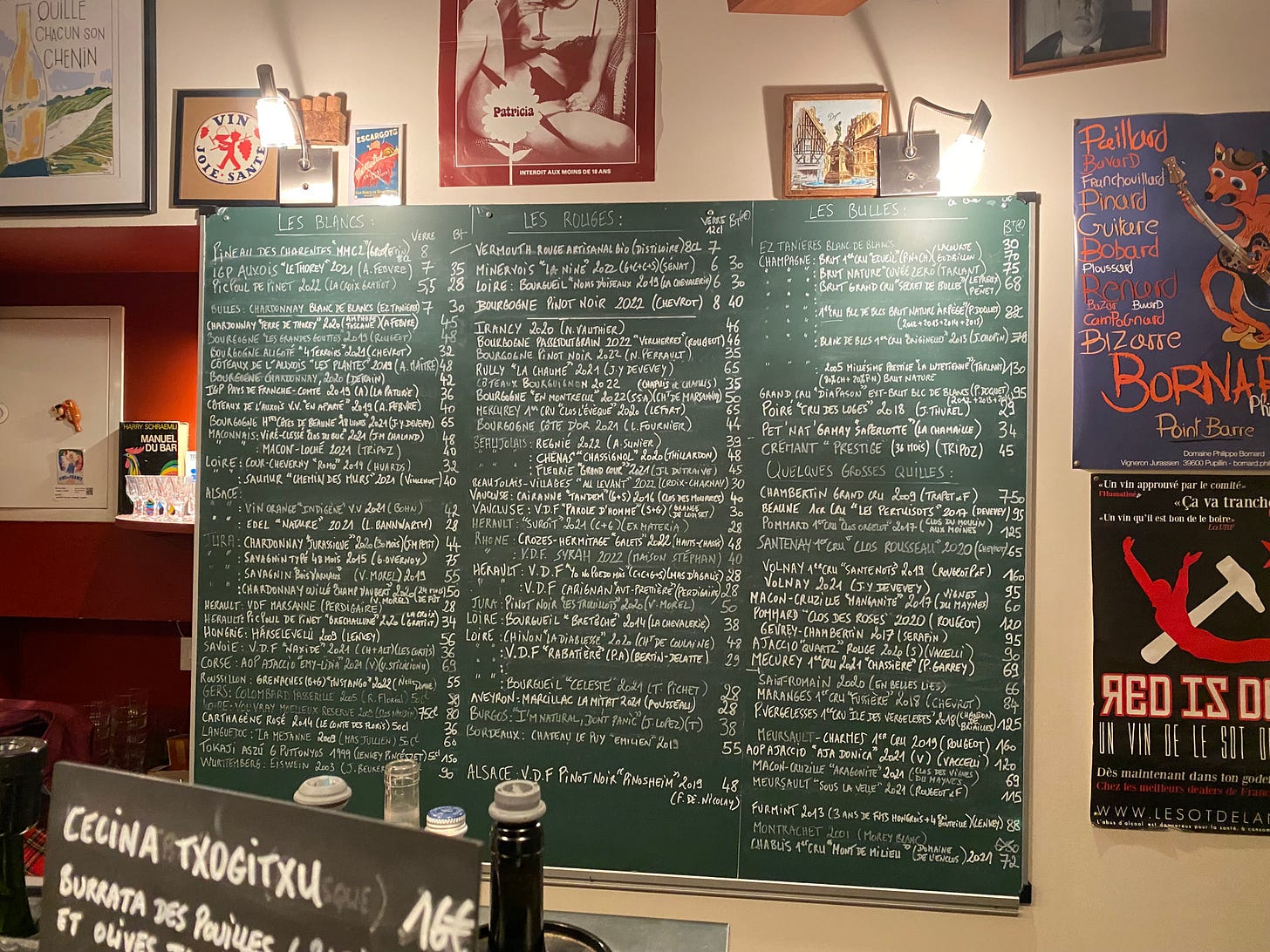On the Alsace beat with Domaine Kirrenbourg (part 2)
The whites examined - including a trio of excellent rieslings
This is the second instalment focusing on my tasting at Domaine Kirrenbourg in Alsace. You can find the first part, which looked at pinot noir, here.
Riesling is the most-grown variety in Alsace based on figures released by the Conseil Interprofessional des Vins d’Alsace (CIVA) in 2017 (so admittedly a while ago). A total of 8,357 hectares in the region were dedicated to riesling, marginally more than pinot blanc (8,192ha), which is the main variety used for cremant d’Alsace, with 7,598ha of gewürztraminer grown.
It is therefore no surprise that Domaine Kirrenbourg makes a range of different riesling cuvees using different plots in the grand crus of Schlossberg and Brand.
I first tasted the ‘entry-level’ riesling Roche Granitique 2020, which had high acidity and was linear in style, with red apple, honeysuckle and stone fruit. It was a good example of a fresh riesling, highlighting the characteristics of the grape rather than a particular grand cru, and you’re getting bang for your buck when you consider it’s a blend of grand cru and non-grand cru plots.
This strategy of blending different plots gives a good insight into the quality tiers that Kirrenbourg employs. Whereas some producers in Alsace label their wines ‘grand cru’ because the grapes all come from grand cru sites, regardless of the actual quality of the grapes, Kirrenbourg adopts a more selective approach, and is not afraid to declassify.
As Marine Claude, Kirrenbourg sales manager, explains: “We do plot-by-plot harvests that allows us to taste the plots separately and we will then make our blend to separate our three qualities of wine.
“Each plot has its own particularity, and that is why we can declassify some grand cru plots to nourish the Alsace AOC plots, in order to get the more balanced and qualitative wine.
“For example, the Riesling Roche Granitique is always a blend of grand cru and non-grand cru plots and have an amazing quality for an ‘entry level’ signature wine.
“This is also our strength: we don’t have to produce every year the same volume of bottles for each range. We are sure that we produce the best quality every year and that is also reassuring for our clients.”
I next tasted the riesling ‘Terroir S’ 2019 (34 euros), which was a standout for me, despite it not thought good enough at the time to be designated ‘grand cru’ on the label. Marine added: “We thought that we could produce an even longer, more complex and deeper grand cru, that is why we declassified it, even if the wine is amazing itself.”
From Schlossberg parcels, this was complex, with characteristics of lime, pineapple and stone fruit with some petrol coming through with age. It has excellent texture with the 14% abv not too overpowering. This demonstrates the strength of 2019 vintage and it is drinking beautifully now.
The final riesling I tried was the grand cru Schlossberg 2020 (47 euros). It is rich, full-bodied with tropical and stone fruit and still has a long way to go. I would love to taste this again in about three years’ time to see how it has progressed.
In the 1960s sylvaner was the most-grown white variety in Alsace, but only 2,614 hectares were grown in 2017 as the popularity of riesling, pinot blanc and pinot gris has grown, but this variety (known as silvaner in Germany and the signature white grape in the Franken region) has been unfairly labelled as producing dull wine (it is thought to express itself best in the Zotzenberg grand cru in the north of Alsace).
I was taken by Kirrenbourg’s ‘Terrior B’ sylvaner (27 euros), which gained extra texture from nine months’ ageing on the lees, and was a reminder that not only the four ‘noble varieties’ of pinot gris, gewürztraminer, riesling and muscat have the capacity to produce excellent wine.
One of the highlights of the tasting was a Schlossberg Pinot Gris 2021 ‘Muid’, a departure from fruit-forward styles one tends to associate with whites from Alsace as the wine underwent elevage in demi-muids, large, 600-litre wooden vats that are often used in Chateauneuf-du-Pape in the Southern Rhone.
A barrel this size is unlikely to impart a large degree of oak flavour to the wine, but a lot depends on the cooperage. The demi-muids used for the pinot gris were made by the famed Dussiaux Cooperage, and as Marine explained, the barrels’ construction had an impact on the resulting style. She said: “Monsieur Dussiaux splits and not saws the wood.
“He also has a rather powerful heating technique which was thought would result in strong tannins, but that is actually not the case and we can see his touch with smoky flavours.”
There was a pleasing, toasty finish to the wine, a style I had yet to associate with pinot gris, but it worked very well.
Another style not readily associated with Alsace is orange wine, but a lot of the producers I visited are now making this ultra-trendy wine and Kirrenbourg is no exception. Gewürztraminer tends to be the go-to variety for making orange wine in the region, its pronounced aromatics helping to give the resulting wine character. The ‘Les Origines’ 2019 (29 euros) undergoes skin contact for 15 days, a relatively short period of time for this style. It is more fruit than funky.
If you plan to visit Alsace then I thoroughly recommend booking a trip to Kirrenbourg – you’re unlikely to be disappointed. Alternatively, if you’re based in the UK and want to check out the producer’s wines, Naked Wines currently stock the riesling Roche Granitique and the Schlossberg K Grand Cru riesling 2019, and Raeburn Fine Wines import a comprehensive range.
Flight 24 – More French adventures
Domaine Eric Rominger Grand Cru Zinnkoepfle Riesling 2016 (12 euros a glass)
For wine lovers travelling through Colmar, Le Cercle Des Aromas is a must-visit as the wines by the glass are fantastic, including this one. Pale gold in colour, with rich honey, dried stone fruit and traces of walnuts. Eric Rominger is based in Westhalten, south of Colmar, and the neighbouring Zinnkoepfle grand cru is characterised by a unique mediterranean microclimate, but the warmth is tempered by its altitude – it’s the highest grand cru in Alsace. Vinatis stock this riesling at £25, which is good value.
Domaine Dirler Cade Grand Cru Spiegel riesling 2018 (12 euros a glass)
Dirler Cade is based in Bergholtz, just to the south of Westhalten. The Spiegel grand cru is renowned for producing fresh wines, and this is what is exhibited in this riesling. Pale lemon and citrus-focused, with some honeysuckle and maybe some dried apricot on the finish. High acidity and will age well. Hay Wines import this for £33.
Chateau de Marsannay 2020 pinot noir (12 euros a glass)
Chez Bruno is a wine bar worth checking out in Dijon, but it has somewhat erratic opening times. I was lucky to stumble on it when it was in fact open and had a glass of this ripe pinot, which exhibited red and black fruit with spice, vanilla and cedar. Medium tannin and long finish. Ideal for those who like their Burgundy pinot in a fuller style.






